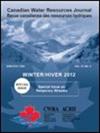Combining large-scale and regional hydrological forecasts using simple methods
IF 0.9
4区 环境科学与生态学
Q3 WATER RESOURCES
引用次数: 0
Abstract
AbstractThe development and expanded application of large-scale hydrological models has produced forecasts that often overlap with more targeted, regional hydrological forecasts. Here the possibility is explored for using simple methods to combine forecasts from a large-scale model, the Great Lakes portion of the National Surface and River Prediction System (NSRPS), and a regional system, the Système de Prévision Hydrologique (SPH) which covers southern Quebec, to improve regional forecasts. Outputs from the two forecasting systems are combined using multiple methods, including the simple mean, a weighted average in which the weights are optimized using the Kling-Gupta Efficiency (KGE), the Reduced Continuous Ranked Probability Score (RCRPS), and Ignorance Score (IGN) as cost functions, and weights calculated from the residual errors of the models. Bayesian Model Averaging (BMA) is also used to combine the probabilistic forecasts from both systems. The results show that it is possible to improve regional hydrological forecasts by using simple weighted combinations with forecasts from the large-scale system, even though the regional system performs clearly better. Performance is assessed via many well-known metrics, such as Nash-Sutcliffe Efficiency (NSE), KGE, RCRPS, and IGN. Results are averaged over 40 gauging stations and analyzed at lead times from 3 to 120 h. Improvements in all criteria for lead times over 60 h are observed, and there is no loss in performance at any lead times. Finally, the methods are used in a leave-one-out setup containing 29 validation basins to simulate performance on ungauged basins. The performance gain for ungauged basins is similar to that of the gauged basins, demonstrating that these simple methods can also improve forecasts in more remote territories where no gauging is available.RésuméLe développement et l’application étendue des modèles hydrologiques large-échelle ont produit des prévisions qui chevauchent régulièrement des prévisions hydrologiques régionales, plus spécifiques à un territoire. Cette étude porte sur l’utilisation de méthodes simples permettant la combinaison des prévisions large-échelle de la partie des Grands Lacs du National Surface and River Prediction System (NSRPS) aux prévisions régionales du Système de Prévision Hydrologique (SPH) qui couvre le sud du Québec, afin d’améliorer ces prévisions régionales. Les sorties de ces deux systèmes sont combinées selon plusieurs méthodes incluant la moyenne simple, des moyennes pondérées qui utilisent comme fonction de coût le Kling-Gupta Efficiency (KGE), le Reduced Continuous Ranked Probability Score (RCRPS) et l’Ignorance Score (IGN), en plus de poids calculés selon les résidus des modèles. Le Bayesian Model Averaging (BMA) est aussi utilisé pour combiner les prévisions des systèmes. Les résultats montrent qu’il est possible d’améliorer les prévisions hydrologiques régionales en utilisant de simples combinaisons pondérées avec les prévisions du système large-échelle, et ce même si le système régional performe mieux que le système large-échelle. La performance est évaluée selon plusieurs métriques bien connues, telles que le Nash-Sutcliffe Efficiency (NSE), KGE, RCRPS et IGN. Les résultats sont moyennés sur 40 stations de jaugeage et analysés pour des horizons de 3 à 120 h. Des améliorations sont observées sur tous les critères pour des horizons de 60 h et plus, et aucune perte de performance n’est observée sur tous les horizons. Finalement, les méthodes de combinaison sont utilisées dans une configuration « leave-one-out » contenant 29 bassins de validation afin de simuler la performance des combinaisons sur les bassins non-jaugés. Le gain en performance pour les bassins non-jaugés est similaire au gain des bassins jaugés, démontrant que ces méthodes simples pourraient aussi améliorer les prévisions des territoires plus éloignés où des stations de jaugeage ne sont pas disponibles.Keywords: Bayesian model averaginghydrologic post-processinghydrological forecastingforecast merging Disclosure statementNo potential conflict of interest was reported by the author(s).Data availability statementThe data that support the findings of this study are available from the corresponding author, [MAB], upon reasonable request.Additional informationFundingThe work described in this article has been un- dertaken as part of a research contract funded by the government of Quebec.采用简单方法结合大尺度和区域水文预报
摘要随着大尺度水文模型的发展和应用的扩大,预测结果往往与更有针对性的区域水文预测相重叠。这里探讨了使用简单方法将来自大型模型的预报结合起来的可能性,即国家地表和河流预报系统(NSRPS)的五大湖部分,以及覆盖魁北克省南部的区域系统,即pracrivision Hydrologique系统(SPH),以改进区域预报。两个预测系统的输出使用多种方法进行组合,包括简单平均值,加权平均值,其中权重使用克林-古普塔效率(KGE),减少连续排名概率分数(RCRPS)和无知分数(IGN)作为成本函数进行优化,以及从模型的残差计算的权重。贝叶斯模型平均(BMA)也被用于结合两个系统的概率预测。结果表明,尽管区域系统的预报效果明显更好,但通过与大尺度系统预报的简单加权组合来改进区域水文预报是可能的。性能是通过许多众所周知的指标来评估的,比如纳什-萨特克利夫效率(NSE)、KGE、RCRPS和IGN。结果在40个测量站上进行平均,并在3至120小时的交货时间内进行分析。在超过60小时的交货时间内,观察到所有标准都有所改善,并且在任何交货时间内都没有性能损失。最后,将这些方法用于包含29个验证盆地的留一设置中,以模拟未测量盆地的性能。未测量盆地的性能增益与测量盆地相似,表明这些简单的方法也可以改善没有测量的偏远地区的预测。汇通汇通汇通汇通汇通汇通汇通汇通汇通汇通汇通汇通汇通汇通汇通汇通汇通汇通汇通汇通汇通汇通汇通汇通汇通汇通汇通汇通汇通汇通汇通汇通汇通汇通汇通汇通汇通汇通汇通汇通汇通汇通汇通汇通汇通汇通汇通汇通汇通汇通汇通汇通汇通汇通汇通汇通汇通汇通汇通汇通汇通汇通汇通汇通汇通汇通汇通汇通汇通汇通汇通汇通汇通汇通汇通汇通汇通汇通汇通汇通汇通。单一的、简单的、渗透的、混合的、大型的、由国家地表和河流预报系统(NSRPS)组成的、由系统组成的、由系统组成的、由系统组成的、由系统组成的、由系统组成的、由系统组成的、由系统组成的、由系统组成的、由系统组成的、由系统组成的、由系统组成的、由系统组成的、由系统组成的、由系统组成的。混合混合系统的混合混合系统,包括简单的混合混合系统,混合混合系统,混合混合系统,混合混合系统,混合混合系统,混合混合系统,混合混合系统,混合混合系统,混合混合系统,混合混合系统,混合混合系统,混合混合系统,混合混合系统,混合混合系统,混合混合系统,混合混合系统,混合混合系统,混合混合系统,混合混合系统。勒贝叶斯模型平均(BMA)是一种实用的混合系统。时候montrent说它可能d改进Les > hydrologiques地区现在de simples combinaisons ponderees用莱斯> du systeme large-echelle et ce meme si勒地区performe mieux缆车和large-echelle。这些性能指标包括:纳什-萨特克利夫效率(NSE)、KGE、RCRPS和IGN。结果的平均值在40台德jaugeage等分析倒3 des视野de 120 h。des是经验观察苏尔准则分为满分倒des视野de 60 h +,等没有任何perte de性能n是observee苏尔全部的视野。最后,将3种不同的混和器组合在一起,使用3种混和器组合在一起,配置“留一个”,29种混和器组合在一起,性能组合在一起,使用4种混和器组合在一起,非混和器组合。在不同的分类中,不同的分类与不同的分类相似,不同的分类与不同的分类,不同的分类与不同的分类,不同的分类,不同的分类,不同的分类,不同的分类,不同的分类,不同的分类,不同的分类,不同的分类,不同的分类,不同的分类,不同的分类。关键词:贝叶斯模型平均水文后处理水文预报预报合并披露声明作者未报告潜在利益冲突。数据可用性声明支持本研究结果的数据可根据合理要求从通讯作者[MAB]处获得。本文所描述的工作是由魁北克政府资助的一项研究合同的一部分。
本文章由计算机程序翻译,如有差异,请以英文原文为准。
求助全文
约1分钟内获得全文
求助全文
来源期刊

Canadian Water Resources Journal
WATER RESOURCES-
CiteScore
2.90
自引率
5.90%
发文量
17
审稿时长
>12 weeks
期刊介绍:
The Canadian Water Resources Journal accepts manuscripts in English or French and publishes abstracts in both official languages. Preference is given to manuscripts focusing on science and policy aspects of Canadian water management. Specifically, manuscripts should stimulate public awareness and understanding of Canada''s water resources, encourage recognition of the high priority of water as a resource, and provide new or increased knowledge on some aspect of Canada''s water.
The Canadian Water Resources Journal was first published in the fall of 1976 and it has grown in stature to be recognized as a quality and important publication in the water resources field.
 求助内容:
求助内容: 应助结果提醒方式:
应助结果提醒方式:


